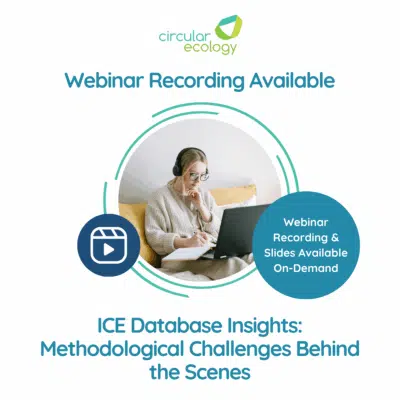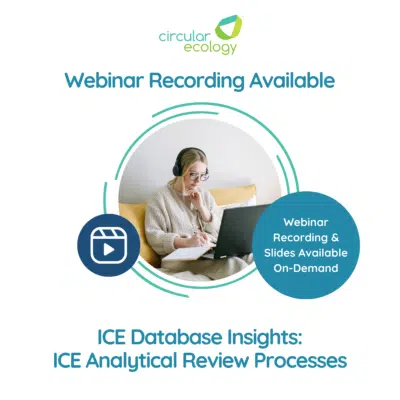Carbon Offsets – Frequently Asked Questions
Find below answers to our frequently asked questions on carbon offsetting with Circular Ecology. If your question is not on the list, please feel free to reach out to us directly.
A carbon footprint is the amount of greenhouse gas emissions that are released into the atmosphere as a result of a defined activity. This could be the carbon footprint of a flight to New York, to make a cotton T-Shirt, heat your home, or any activity, product, energy consumption …etc.
A carbon footprint considers the big picture perspective and accounts for the carbon emissions no matter where in the world they occurred.
In the case of the carbon footprint to make a T-Shirt, it would account for the growing of cotton on a farm (energy, fertiliser, waste…etc), the transport of cotton to various production factories, such as yarn production, weaving, cutting and sewing…etc, and the packaging and delivery to customer. It could also include the life cycle of the cotton T-Shirt, including laundry, drying and finally the end of life disposal or recycling.
There is a lot to consider as a part of a carbon footprint. However, there is now a lot of data out there that has already calculated this for us.
A carbon offset is a way of reducing our emissions by supporting carbon reduction projects. These projects may be renewable, forestry, clean cook stoves, clean water, biogas, methane capture, and more.
A carbon offset is also known as a carbon credit, where 1 carbon credit is a 1 tonne CO2e carbon reduction. There are several main carbon offset schemes, which produce and verify carbon credits, such as VCS, Gold Standard, Plan Vivo and the UN Clean Development Mechanism (UN CDM).
A carbon credit is a carbon offset of 1 tCO2e. Likewise, 1,000 carbon credits is equal to a carbon reduction of 1,000 tonnes CO2e.
It is important to ensure that the carbon offsets are real. For that reason, we only use carbon offsets from high quality carbon offset schemes. These include VCS, Gold Standard, Plan Vivo and the UN Clean Development Mechanism.
These schemes all have processes and procedures in place to ensure that their offsets are:
- Additional – ensuring that the reductions are realistic
- Verified – providing assurance on the quality and credibility of carbon reductions
- Traceable – they all have a registry system to ensure that offsets are traceable and that they are retired, meaning that they cant be double sold
Greenhouse gases (GHGs) are a group of gases that if released into the atmosphere, contribute to climate change and global warming.
There are a basket of 6 greenhouse gases:
- carbon dioxide (CO2)
- methane (CH4)
- nitrous oxide (N2O)
- hydrofluorocarbons (a group of gases)
- perflurorocarbons (a group of gases)
- sulphur hexafluoride (the most potent GHG known to date)
These gases form the basis for a carbon footprint, where their impact is all measured relative to releasing carbon dioxide into the atmosphere, this is known as carbon dioxide equivalents, or CO2e. The little ‘e’ at the end of CO2e, demonstrates that all 6 GHGs have been considered as part of the carbon emissions.
We plant 1 tree for every 1 tCO2e offset through Offset My Life, with no exceptions. We are passionate about tree planting and believe that it brings many wider benefits.
The trees are planted through the Eden Reforestation Projects, who are a non-profit organisation. They are arranged once a quarter.
They plant the trees in locations such as Madagascar, Haiti, Nepal, Indonesia, and Mozambique. These are all nations that have been ravished by deforestation.
Trees provide a habitat for animals, purify water sources, control flooding and erosion and help to replenish the soil with nutrients needed for farming.
The trees are planted through the Eden Reforestation Projects. We arrange for trees to be planted once a quarter, the Eden Reforestation Projects will then arrange for the trees to be planted in one of their locations such as Madagascar, Haiti, Nepal, Indonesia, and Mozambique.
For a business to go carbon neutral, or release a net zero carbon product, building…etc, it needs to be done to the highest level of assurance.
The first step is therefore to have a detailed carbon footprint assessment, in accordance with a recognised and high quality carbon footprint standard. This includes the World Resources Institute (WRI) GHG Protocol for organisational carbon footprints.
For products it may include the GHG Protocol for products, PAS 2050 or ISO 14067, amongst others.
For building materials and entire buildings and construction projects it could include EN 15804, EN 15978 or PAS 2080.
This provides the basis for the amount of carbon to offset, to make carbon neutral. It is recommended to have the carbon footprint calculated externally verified, to provide the final level of assurance.
Finally, the carbon offsets must be high quality and it is recommended to use VCS or Gold Standard carbon offsets for carbon neutrality. These would meet the needs of carbon neutrality standards such as PAS 2060: Carbon Neutrality, from the British Standards Institute.
The Verified Carbon Standard (VCS) is the world’s most widely used voluntary carbon offset scheme. It is operated and managed by Verra, who also manage other schemes such as the Climate, Community & Biodiversity (CCB) Program.
VCS offsets are popular and widely available for most project types.
The Gold Standard is one of the main voluntary carbon offset schemes. Some consider it to be the highest quality carbon offsets available, due to the wider benefits that their offset projects also bring. Gold Standard offsets are widely available for most project types, although there are typically not many projects for forestry, which are typically available to different standards.
Plan Vivo is managed by the Plan Vivo Foundation, which is an Edinburgh based charity which has created a set of requirements for smallholders and communities wishing to manage their land and natural resources more sustainably.
The Plan Vivo carbon offset projects are typically in land use and forestry, which are a popular offset project type. Plan Vivo is internationally recognised for its focus on ethical and fairly-traded climate services, meaning a greater share of climate finance (60+%) reaches those who most need it.
The United Nations Clean Development Mechanism (UN CDM) was originally created to promote clean development in developing countries.
The UN CDM also allowed countries to reduce their emissions under the Kyoto Protocol (Annex B Party) through implementing emission-reduction projects in developing countries.
For every 1 tonne of CO₂e offset through Circular Ecology, we divert £1 of this to support our release of free data, tools and resources.
This includes the Inventory of Carbon and Energy (ICE) database, and various other tools that we periodically release for free. You can view our resources section to find out more.
If you are interested in offsetting your carbon, you can view our carbon offset products on our store.
Webinar Recap: ICE Insights: Methodological Challenges Behind the Scenes
Circular Ecology hosted the fourth webinar in the ICE Database Insights webinar mini series on [...]
Jun
DESNZ (Defra) 2025 GHG Emissions Factors Released
The UK Department for Energy Security and Net Zero (DESNZ) have just released the 2025 [...]
Jun
Webinar Recap: ICE Insights: Are All EPDs Created Equal?
On Thursday, 22nd May, Circular Ecology hosted the third instalment in the ICE Database Insights [...]
May
Webinar Recap: ICE Insights: ICE Analytical Review Processes
On Wednesday, April 30th, Circular Ecology hosted the second session of our ICE Database Insights [...]
Apr




